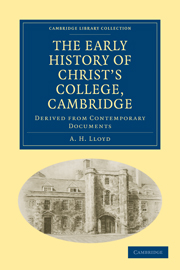Book contents
- Frontmatter
- Preface
- Contents
- LIST OF ILLUSTRATIONS
- List of Abbreviations
- Chronological Summary
- Dedication
- Chapter I William Byngham, the First Founder
- Chapter II The Dispute with John Langton
- Chapter III The First Royal Licence, 1439
- Chapter IV The Expansion of the Milne Street Site
- Chapter V The Royal Licences of 1442
- Chapter VI Marking Time: 1443 to 1446
- Chapter VII The Royal Licence of 1446 and its period
- Chapter VIII The Foundation Charter of the College of Godshouse and its period
- Chapter IX The Relationship of Godshouse and Clare Hall
- Chapter X The Last Days of William Byngham
- Chapter XI The Proctorship of John Hurte, 1451–1458, and of William Fallan, 1458–1464
- Chapter XII The Proctorship of William Basset, 1464–1477
- Chapter XIII The Proctorship of Ralph Barton, 1477–1490
- Chapter XIV The Proctorship of John Syclyng: Early Years, 1490–1496
- Chapter XV The Proctorship of John Syclyng: Later Years, 1496–1506
- Chapter XVI The Negotiations between Godshouse and the Lady Margaret
- Chapter XVII Syclyng's Death and Will
- Chapter XVIII The Buildings and Furniture remaining from the Godshouse period
- Chapter XIX Godshouse and Christ's College
- Appendix
- Index
- Plate section
Chapter III - The First Royal Licence, 1439
Published online by Cambridge University Press: 05 October 2010
- Frontmatter
- Preface
- Contents
- LIST OF ILLUSTRATIONS
- List of Abbreviations
- Chronological Summary
- Dedication
- Chapter I William Byngham, the First Founder
- Chapter II The Dispute with John Langton
- Chapter III The First Royal Licence, 1439
- Chapter IV The Expansion of the Milne Street Site
- Chapter V The Royal Licences of 1442
- Chapter VI Marking Time: 1443 to 1446
- Chapter VII The Royal Licence of 1446 and its period
- Chapter VIII The Foundation Charter of the College of Godshouse and its period
- Chapter IX The Relationship of Godshouse and Clare Hall
- Chapter X The Last Days of William Byngham
- Chapter XI The Proctorship of John Hurte, 1451–1458, and of William Fallan, 1458–1464
- Chapter XII The Proctorship of William Basset, 1464–1477
- Chapter XIII The Proctorship of Ralph Barton, 1477–1490
- Chapter XIV The Proctorship of John Syclyng: Early Years, 1490–1496
- Chapter XV The Proctorship of John Syclyng: Later Years, 1496–1506
- Chapter XVI The Negotiations between Godshouse and the Lady Margaret
- Chapter XVII Syclyng's Death and Will
- Chapter XVIII The Buildings and Furniture remaining from the Godshouse period
- Chapter XIX Godshouse and Christ's College
- Appendix
- Index
- Plate section
Summary
The editors of Documents relating to the University and Colleges of Cambridge had no knowledge of John Langton's dispute with Byngham, and they very properly introduced the Godshouse series with Byngham's petition to the king, which it is usual to attribute to the year 1439. The petition, as is customary at that period, does not beara date,but the king's licence of 13 July 1439 was obviously its outcome, and it is reasonable to ascribe to the petition a date late in 1438 or early in 1439 in order to leave adequate margin for the slow motion of the law machinery. Byngham's petition has been printed many times but always directly or indirectly from the same source, the only contemporary copy of the petition known being that still remaining in the muniment room of King's College. It is printed afresh in the appendix, immediately before the royal licence given in answer to it.
It should be noted that the King's College document is not the original petition, as is generally implied, and sometimes specifically stated; the original would be sent to the king and retained. Such petitions occasionally remain amongst the Chancery Warrants, in immediate contact with the warrant for the licence if the prayer of the petition be granted. The warrant has been found in File No. 719 (4921 A), and runs:
Henri par la grace de dieu roy etc. A loneurable pere en dieu levesque de Bath nostre Chanceller saluz. Nous volons de ladvis et assent de nostre counsail et vous mandons que selonc la conteneue dune copie quelle nous vous envoions dosee dedeins ycestes vous facez faire noz lettres patentes desoubz nostre grand seal en due fourme. […]
- Type
- Chapter
- Information
- The Early History of Christ’s College, CambridgeDerived from Contemporary Documents, pp. 35 - 43Publisher: Cambridge University PressPrint publication year: 2010First published in: 1934



